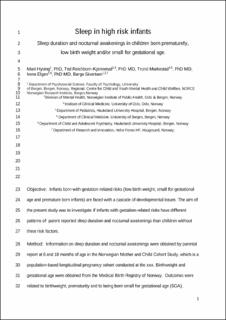| dc.description.abstract | Objective:
Infants born with gestation-related risks (low birth weight (LBW), small for gestational age (SGA), and prematurely born infants) are faced with a cascade of developmental issues. The aim of this study was to investigate whether infants with gestation-related risks have different patterns of parent-reported sleep duration and nocturnal awakenings than children without these risk factors.
Methods:
Information on sleep duration and nocturnal awakenings was obtained by parental report at age 6 and 18 months in the Norwegian Mother and Child Cohort Study, which is a population-based longitudinal pregnancy cohort study conducted at the Norwegian Institute of Public Health. Birth weight and gestational age were obtained from the Medical Birth Registry of Norway. Outcomes were related to birth weight, prematurity, and to being born SGA.
Results:
A total of 75,531 mother-child dyads were included. Compared with children without gestational risks, children born SGA and with LBW had shorter sleep duration, whereas children born prematurely had longer sleep duration at both time points. The infants born SGA and with LBW, but not the prematurely born children, had fewer nocturnal awakenings at 6 months, but all had more awakenings at 18 months.
Conclusion:
Infants with gestation-related risks show distinct sleep patterns. We suggest that sleep assessment is included in the follow-up of high-risk infants. Future studies are needed to investigate the predictive value and functional importance of the sleep patterns for infants with gestation-related risks. | |
